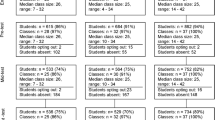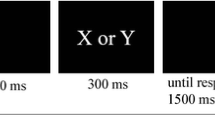Abstract
A single session intervention was given individually to 4 adults in order to assist them in achieving their personal goals by improving their behavioral skills for achieving the goals and their conceptual understanding of & #x201C;how to & #x201D; attain these goals. The method was based on a brain-ability analysis of understanding & #x201C;conservation & #x201D; on Jean Piaget's conservation tasks combined with Paul and Gail Dennison's Brain Gym & #x201C;balance & #x201D; procedure. My & #x201C;whole brain understanding & #x201D; model (C. A. Wolfsont, 1999, 2000) and M. L. Commons et al.'s Hierarchical Complexity Scoring System manual were used to analyze the verbal protocols (M. L. Commons et al., 1992; Commons, Danaher, & Meaney, 2000). Increases were found in the participants' conceptual understanding and in the complexity of their performance.
Similar content being viewed by others
REFERENCES
Alexander, C. N., & Langer, E. J. (Eds.). (1990). Higher stages of human development: Perspectives on adult growth. New York: Oxford University Press.
Armon, C. (1984). Ideals of the good life and moral judgment: Ethical reasoning across the life span. In M. L. Commons, F.A. Richards, & C. Armon (Eds.), Beyond formal operations: Late adolescent and adult cognitive development (pp. 357-380). New York: Praeger.
Baldwin, A. L. (1967). Theories of child development. New York: Wiley.
Commons, M. L. (1994). Asummary of the general model of hierarchical complexity (GMHC; GSM). Behavioral Developments, 4(2), 6-7.
Commons, M. L., Danaher, D., & Meaney, M. (2000). Transition and stage in performance of Harvard University faculty and staff. In M. L. Commons, D. Danaher, P. M. Miller, E. A. Goodheart, & T. L. Dawson (Eds.), Hierarchical complexity scoring system (HCSS): How to score anything. (Available from Commons@tiac.net or Michael L. Commons, Program in Psychiatry and the Law, 74 Fenwood Road, Boston, MA 02115.)
Commons, M. L., Johnstone, J., Straughn, J.B., Meaney, M., Weaver, J. H., Lichtenbaum, E., & Krause, S. (1992). Measuring stage of development across domains: A universal scoring scheme. Available from commons@tiac.net or Michael L. Commons, Program in Psychiatry and theLaw, 74Fenwood Road, Boston, MA 02115.
Commons, M. L., & Miller, P. M. (1998). A quantitative behavior-analytic theory of development. Mexican Journal of Experimental Analysis of Behavior, 24(2), 153-180.
Commons, M. L., & Richards, F. A. (2002). Organizing elements into combinations: How stage transition works. Adult Development, 9(3), 157-175.
Cook-Greuter, S. R. (1999). Results of a study of the nature and measurement of postautonomous ego development. Poster session presented at the Fourteenth Annual Adult Development Symposium, Salem, MA.
Danaher, D. L. (2000). An example of applying the general stage model to scoring the self section of the life experience interview. In M. L. Commons, D. Danaher, P. M. Miller, E. A. Goodheart, & T. L. Dawson (Eds.), Hierarchical complexity scoring system (HCSS): How to score anything. (Available at Commons@tiac.net or Michael L. Commons, Program in Psychiatry and the Law, 74 Fenwood Road, Boston, MA 02115.)
Davidson, R. J., & Hugdahl, K. (Eds.). (1995). Brain asymmetry. Cambridge, MA: The MIT Press.
Dennison, P. E., & Dennison, G. E. (1984). Edu-Kinesthetics indepth: The seven dimensions of intelligence. Ventura, CA: Educational Kinesiology Foundation.
Dennison, P. E., & Dennison, G. (1989). Brain Gym, teacher's edition revised. CA: Edu-Kinesthetics.
Freeman, C. (with Dennison, G.) (1998). I amthe child: Using Brain Gym with children who have special needs. Ventura, CA: Edu-Kinesthetics.
Irving, J. (1996). PACE research keeps in pace with first-year nursing students: A report on a doctoral thesis completed by Jan Irving, Ph.D. Brain Gym Journal, 10(1), pp.3-4.
Kegan, R. (1994). In over our heads: The mental demands of modern life. Cambridge, MA: Harvard University Press.
Kosslyn, S. M. (1994). Image and brain. Cambridge, MA: The MIT Press.
Lam, M. S. (1994). Women and men scientists' notion of the good life. Unpublished doctoral dissertation, University of Massachusetts, Amherst, MA.
Lam, M. S. C. (1999). Applying the general stage model to scoring Armon's good life interview of past postdoctoral fellows. In Commons et al. (Eds.), The general hierarchical complexity scoring system (GHCSS): How to score anything. Unpublished scoring manual available from commons@tiac.net or Michael L. Commons, Program in Psychiatry and the Law, 74 Fenwood Road, Boston, MA 02115.
Loren#x00E7;o, O., & Machado, A. (1996). In defense of Piaget's theory: A reply to 10 common criticisms. Psychological Review, 1, 143-164.
Pascual-Leone, J. (1998). Abstraction, the will, the self, and modes of learning in adulthood. In M. C. Smith & T. Pourchot (Eds.), Adult learning and development: Perspectives from educational psychology (pp. 35-66). New Jersey: Erlbaum.
Piaget, J. (1967). Six psychological studies. New York: Random House.
Piaget, J. (1976). The grasp of consciousness. Cambridge, MA: Harvard University Press.
Piaget, J. (1978). Success and understanding. Cambridge, MA: Harvard University Press.
Sifft, J. M., & Khalsa, G. C. K. (1991). Effect of educational kinesiology upon simple response times and choice response times. Perceptual and Motor Skills, 73, 1011-1015.
Wolfsont, C. A. (1999). Brain Gym and Piaget's model of intelligence. Brain Gym Journal, 8(3), pp. 9, 14-16.
Wolfsont, C. A. (2000). deep understanding balance course manual. Manuscript in preparation.
Author information
Authors and Affiliations
Corresponding author
Rights and permissions
About this article
Cite this article
Wolfsont, C. Increasing Behavioral Skills and Level of Understanding in Adults: A Brief Method Integrating Dennison's Brain Gym & #x00AE; Balance with Piaget's Reflective Processes. Journal of Adult Development 9, 187–203 (2002). https://doi.org/10.1023/A:1016052026435
Issue Date:
DOI: https://doi.org/10.1023/A:1016052026435




